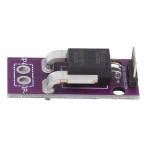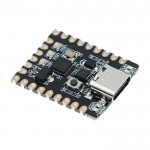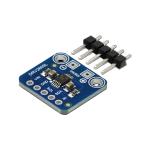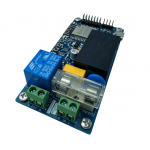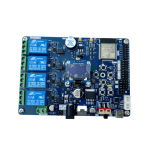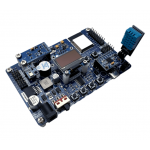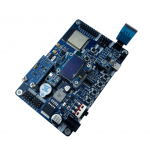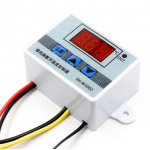Arduino Kits
Arduino Basic Kit Set (UNO R3)
RM70.00
37 in 1 Sensor Kit Set
RM85.00
Arduino Starter Kit Set (UNO R3)
RM125.00
RM70.00
RM85.00
RM125.00
RM35.00
RM85.00
RM4.50
Description/Features: Industry-leading noise performance through proprietary amplifier and filter de..
RM34.00
The Arduino Nano SuperMini Type-C (CH340) is a compact and versatile microcontroller board based on ..
RM22.00
DRV2605L Haptic Motor Driver Controller Board with IN /TRIG General Pin Haptische Motor Driver Modul..
RM43.00
The PIC16F873 is an 8-bit microcontroller from Microchip Technology, based on the PIC® mid-range arc..
RM26.00
This unit is an ESP32-based development board built for IoT applications, specifically to interface ..
RM125.00
This ESP32-powered IoT module is equipped with a 4-channel relay system, tailored for integrating ac..
RM330.00
This IoT Sense Kit is an ESP32-based dev kit that is mainly designed to connect sensors to IoT-based..
RM325.00
This IoT Sense Kit Pro is an ESP32-based dev kit mainly designed to connect sensors to IoT-based sys..
RM365.00
XH-W3002 Digital Temperature Controller (12V/24V/220V) The XH-W3002 is a digital thermostat module ..
RM25.00
Overview The DY-HV20T is a multifunction voice playback module with integrated 20W Class D amplifie..
RM45.00
The PAM8406 Class D amplifier module delivers 5W + 5W stereo output at 5V, offering clear sound with..
RM4.00
This Mini K-Type Thermocouple Male Connector is designed for reliable and accurate temperature sensi..
RM5.00
This MOSFET power module is designed to let your 3D printer handle a heated bed (Hot Bed) with highe..
RM20.00
The F5305 Isolation MOSFET Module is designed for safe and efficient switching in a wide range of ap..
RM5.00
The XL-10AL Bistable switch module allows you to control power just like a self-locking (latching) s..
RM6.50
This Potentiometer Module is the same as your typical potentiometers, except this one has a breakout..
RM5.00
This FPV Pan/Tilt Camera bracket is designed for 9g–12g servos, such as the SG90 with plastic gears...
RM7.00
This module features two 10K potentiometers combined into a single unit. In most cases, you only nee..
RM10.00
DC adjustable booster module LM2587 Module parameters: Input voltage range: 3.5V-30V..
RM18.00
Description: Conventional Constant Voltage Output BOOST Fully Integrated Solutions, Integrated..
RM12.00
RM34.00
Description/Features: Industry-leading noise performance through proprietary amplifier and filter design techniques Integrated shield greatly reduces capacitive coupling from current conductor to die due to high dV/dt signals, and prevents offset drift in high-side, high voltage applications Total output error improvement through gain and offset trim over temperature Small package size, with easy mounting capability Monolithic Hall IC for high reliability Ultra-low power loss: 100 μΩ internal conductor resistance Galvanic isolation allows use in economical, high-side current sensing in high voltage systems 3.0 to 5.5 V, single supply operation 120 kHz typical bandwidth 3 μs output rise time in response to step input current Output voltage proportional to AC or DC currents Factory-trimmed for accuracy Extremely stable output offset voltage Nearly zero magnetic hysteresis Specifications: type: 50A Due to different batches, there may be differences in product appearance and printed text, which not affect use. Material: abs colour: PurpleFull Arduino Code:// === Pin Definitions === const int currentSensorPin = A0; // ACS758 output connected here const int relayControlPin = 8; // Goes to base resistor of transistor // === Sensor Calibration (for ACS758-050B) === const float zeroCurrentVoltage = 2.5; // 2.5V when no current (center voltage) const float sensitivity = 0.04; // 40mV per Amp (for 50A version) void setup() { Serial.begin(9600); // For debugging pinMode(relayControlPin, OUTPUT); // Relay driver pin digitalWrite(relayControlPin, LOW); // Make sure relay is OFF at start } void loop() { int adcValue = analogRead(currentSensorPin); // Read analog voltage float voltage = (adcValue * 5.0) / 1023.0; // Convert to volts float current = (voltage - zeroCurrentVoltage) / sensitivity; // Calc current in amps Serial.print("Voltage: "); Serial.print(voltage); Serial.print(" V, Current: "); Serial.print(current); Serial.println(" A"); // === Threshold Relay Logic === if (current > 10.0) { // If current > 10 Amps digitalWrite(relayControlPin, HIGH); // Turn ON relay } else { digitalWrite(relayControlPin, LOW); // Turn OFF relay } delay(1000); // Wait 1 second before next reading }
RM22.00
The Arduino Nano SuperMini Type-C (CH340) is a compact and versatile microcontroller board based on the ATmega328P chip. Featuring a Type-C USB interface powered by the CH340 chip, it offers fast and reliable connectivity with computers and other devices. Despite its small size, this board retains all the essential features of the classic Arduino Nano, making it perfect for various DIY electronics projects, prototyping, and educational purposes.Specifications of Arduino Nano SuperMini Type-C (CH340):Microcontroller: ATmega328PClock Speed: 16MHzFlash Memory: 32 KB (ATmega328) or which 2 KB used by bootloaderSRAM: 2 KB (ATmega328)EEPROM: 1 KB (ATmega328)USB Interface: Type-C USB connector powered by the CH340 chip for fast and reliable communication.Operating Voltage: 5VInput Voltage (recommended): 7-12 VDigital I/O Pins: 14 (3/5/6/9/11 Support PWM)Analog Inputs: 6 (A0-A5)DC Current per I/O Pin: 40 mADimensions: Compact size similar to the classic Arduino Nano, suitable for embedded projects and prototyping.Datasheet of Arduino Nano SuperMini Type-C (CH340):https://ae01.alicdn.com/kf/S9bbc8a0dcc964122a041745d2540dbf6F.jpghttps://ae01.alicdn.com/kf/Sd3fc5953003747fdb7a5e1ae572cc965x.jpghttps://ww1.microchip.com/downloads/en/DeviceDoc/Atmel-7810-Automotive-Microcontrollers-ATmega328P_Datasheet.pdf
RM43.00
DRV2605L Haptic Motor Driver Controller Board with IN /TRIG General Pin Haptische Motor Driver Module I2C Vin Processor 3V 5V for Arduino Raspberry PiFeature: 1. Control Haptic Motors: The haptic motor controller enables precise control over haptic motors, allowing users to easily open and close these types of motors. It offers various functions such as adjustable vibration levels, different buzzer levels, and even synchronized vibrations with music or audio input.2. Built-in "Strings" with Multiple Effects: The haptic motor driver module provides the capability to combine different effects into a sequence, creating a more immersive haptic projection. By storing and triggering these effects, it allows for a seamless and dynamic feedback mechanism.3. I2C Pin Compatible: With its I2C pin compatibility, this haptic motor driver controller board can interface seamlessly with various devices operating at different logic levels. The built-in pull-up resistors enhance compatibility and simplify the connection process.4. IN/TRIG Pin: The IN/TRIG pin offers flexibility for different applications. It enables users to read analog audio signals and convert them into haptic feedback, enabling synchronization between sound and touch. Additionally, it provides a trigger function to activate specific effects.5. Powered by Vin Processor: With its Vin processor, this haptische motor controller can efficiently power the circuit board and ensure consistent logic levels throughout the system. It simplifies the integration process and allows for seamless compatibility with other microcontroller-based systems.Specification:Origin: Mainland ChinaType: ModuleCondition: NewModel Number: Haptic Motor Controllercolor: blueEmbedded processor:Vin: Powers the board and gives it the same power level as a microcontroller, e.g. 5V micro (eg for Arduino), uses 5VGND: power and logicCommon ground for I2C pins:SCL: I2C clock pin, connected to the I2C clock line of the microcontroller. This pin can be used with 3V or 5V logic, there is a 10K pull-up resistor on this pinSDA: I2C data pin, connected to the I2C data line of the microcontroller. This pin can be used with 3V or 5V logic circuits, this pin 10K pull-up on IN/TRIG: This is a general purpose pin and can be used for several purposes. One use is to read the analog audio input to control audio to haptic codes, and the other is to "trigger" effects instead of sending I2C commands.Size: 18x15x3 (mm)/0.71x0.59x0.12inch1. The DRV2605 is a nice little motor driver. It is not designed to control stepper motors or DC motors, but is specifically designed to control haptic motors - buzzer and vibration motors.2. The chip is controlled by I2C. After initialization, multiple "string" effects can be stringed into the chip memory, and then triggered to drive continuously. Built-in effects are far better than "on" and "off" and will make your tactile sense even better.Features:1. Control haptic motor: This product is specially used to control haptic motor. It is usually only necessary to turn these types of motors on and off.When driving a vibrating motor, this drive has several effects. For example, up and down vibration levels, different buzzer levels, and even vibration will follow the music/audio input.2. Built-in "strings" of multiple effects: After the product is initialized, the "strings" of multiple effects can be stringed together in the chip memory, and then triggered for continuous actuation,This will give you a better feel for how your tactile projection works.3. With I2C pins: This product has multiple I2C pins that can be used for 3V or 5V logic, and there is a 10K pull-up resistor on this pin.4. With IN/TRIG: This product has an IN/TRIG general-purpose pin that can be used for different purposes, including reading analog audio to control audio to produce tactile codes, and "trigger" effects.5. Using a Vin processor: This product has a Vin processor that can power the board and give it the same logic level as the microcontroller.Note:Due to the different monitor and light effect, the actual color of the item might be slightly different from the color showed on the pictures. Thank you!Please allow 1-2cm measuring deviation due to manual measurement.Arduino CodeWiring for ArduinoYou can easily wire this breakout to any microcontroller, we'll be using an Arduino. For another kind of microcontroller, just make sure it has I2C capability, then port the code - it's pretty simple stuff!Connect Vin to the power supply, (red wire in STEMMA QT version). Use the same voltage that the microcontroller logic is based off of. For most Arduinos, that is 5VConnect GND to common power/data ground (black wire in STEMMA QT version)Connect the SCL pin to the I2C clock SCL pin on your Arduino (yellow wire in STEMMA QT version). On an UNO & '328 based Arduino, this is also known as A5, on a Mega it is also known as digital 21 and on a Leonardo/Micro, digital 3Connect the SDA pin to the I2C data SDA pin on your Arduino (blue wire in STEMMA QT version). On an UNO & '328 based Arduino, this is also known as A4, on a Mega it is also known as digital 20 and on a Leonardo/Micro, digital 2Controller Motor - to motor negative (black wire in STEMMA QT version).Controller Motor + to motor positive (red wire in STEMMA QT version).Install Adafruit_DRV2605 LibraryTo begin controling the motor chip, you will need to install the Adafruit_DRV2605 Library. You can do that by going to the Arduino library manager under Sketch -> Include Library -> Manage Libraries...Then search for DRV2605 and find the Adafruit DRV2605 Library and click InstallWe also have a great tutorial on Arduino library installation at:http://learn.adafruit.com/adafruit-all-about-arduino-libraries-install-useLoad Demo SketchNow you can open up File->Examples->Adafruit_DRV2605->basic and upload to your Arduino wired up to the breakout.Open up the serial console and hold the vibration motor between your fingers.The sketch will play all 123 built-in vibration effects in order. The full list with names is available in the DRV2605 datasheetHere's a screenshot for quick referenceMultiple WaveformsYou can also string together multiple effects in a row, up to 7. Check out the complex example sketch, and setWaveform for each slot. The last slot should be set to 0 to indicate it's the end.When you are ready to place the full waveform sequence, send the go() command!AudioYou can also turn the DRV2605 into an audio-to-vibration driver. Use a 1uF capacitor in series to line level voltage audio into the IN pin, then load up the audio example sketch. If you don't feel anything, try boosting up the source audio volume, it has to be pretty loud!
RM26.00
The PIC16F873 is an 8-bit microcontroller from Microchip Technology, based on the PIC® mid-range architecture. It’s part of the PIC16F87X family and is commonly used in low- to mid-range embedded applications.Core FeaturesArchitecture: 8-bit RISC, Harvard architectureInstruction Set: 35 single-word instructionsOperating Frequency: DC – 20 MHz (with external oscillator)MemoryProgram Memory (Flash): 7 Kwords (14-bit words, 8K bytes)Data RAM: 192 bytesEEPROM Data Memory: 128 bytesStack: 8-level deep hardware stack (not software accessible)I/O and PeripheralsI/O Pins: 22I/O Ports: PORTA, PORTB, PORTCTimers:Timer0: 8-bitTimer1: 16-bitTimer2: 8-bitCapture/Compare/PWM (CCP): 2 modulesAnalog-to-Digital Converter (ADC):5 input channels10-bit resolutionUSART: Yes (supports RS-232 via TX/RX)SPI/I2C: Supports Master/Slave modesWatchdog Timer (WDT): With its own on-chip RC oscillatorBrown-out Reset (BOR): YesPower-on Reset (POR): YesInterruptsMultiple interrupt sources:External interrupt (RB0/INT)PORTB change interruptTimer interruptsPeripheral interrupts (USART, ADC, etc.)Power RequirementsOperating Voltage: 2.0V to 5.5VPower-Saving Features: Sleep mode, WDTSpecial FeaturesIn-Circuit Serial Programming™ (ICSP)In-Circuit Debugging (ICD) supportCode protectionProgrammable pull-ups on PORTB
RM125.00
This unit is an ESP32-based development board built for IoT applications, specifically to interface with actuators in connected systems. It features a single integrated relay switch for direct device control and offers multiple I/O pins for attaching additional sensors or actuators as needed. For local input, it includes two onboard push buttons. The board is compatible with Arduino IDE, MicroPython, and other platforms that support Espressif chipsets, including ESP-IDF. Designed for flexibility, this module caters to engineers, researchers, and hobbyists working on embedded systems. Its reliability makes it well-suited for both R&D environments and continuous-use scenarios like 24/7 automation systems.SpecificationsMCU: ESP-32Supports 802.11 b/g/n Wi-Fi connectivity with speeds up to 150 Mbps.Support for both Classic Bluetooth v4.2 and BLE specifications.One integrated relay switch to control a deviceInput: 2×Pushbuttons10×GPIO pins (Follow original ESP32 functions)Power LED1×3.3V I2C portVoltage output pins: 1×3.3V/100mA, 1×5V/100mAUSB Type-C portUSB-to-UART BridgeTemp: -40 ~ 85 (℃)Flash: 4 MBPSRAM: 520 KBSize: 96 x 46 mmAntenna: PCBInterfaces: I/O, I2C , USBFor more detailed information, the user manual can be downloaded [here]
RM330.00
This ESP32-powered IoT module is equipped with a 4-channel relay system, tailored for integrating actuators into smart systems. With four built-in relays, it enables direct control over multiple devices. The board also provides multiple I2C and general-purpose I/O pins to support a variety of external sensors and actuators, offering great flexibility for expansion. Onboard components include an OLED screen, buzzer, and four tactile buttons, delivering essential input/output capabilities. Compatible with Arduino IDE, MicroPython, and other Espressif-supported environments such as ESP-IDF, the board is a practical tool for both prototyping and production. Its robust design suits industrial deployments, while remaining accessible to developers, engineers, and hobbyists working in IoT and embedded system applications.SpecificationsMCU: ESP-32Supports 802.11 b/g/n Wi-Fi connectivity with speeds up to 150 Mbps.Support for both Classic Bluetooth v4.2 and BLE specifications.Four integrated relay switches to control devicesInput: 4×Pushbuttons13×GPIO pins (Follow original ESP32 functions)Output: OLED display, Buzzer, LEDI2C: 3×5V I2C pins, 3×3.3V I2C pinsVoltage output pins: 4×3.3V/200mA, 4×5V/600mA2×Dry contacts with debouncing filterUSB-to-UART BridgeResettable FusePower Mode Selector SwitchCompatibility with Arduino IDE, MicroPython, and other Espressif chips compatible platformsTemp: 40 ~ 85 (℃)Flash: 4 MBPSRAM: 520 KBSize: 122 x 88 mmInterfaces: I/O, I2C, One-wire, USBAntenna: PCBFor more detailed information, the user manual can be downloaded [here]
RM325.00
This IoT Sense Kit is an ESP32-based dev kit that is mainly designed to connect sensors to IoT-based systems. It has various sensors integrated into the board, such as Temperature, Humidity, Light Intensity, Pressure, Accelerometer, and Gyroscope. These sensors can detach from the unit and mount outside the board using wire extensions. Further, it has a range of I/O pins for connecting other sensors or actuators according to user requirements. The OLED display, buzzer, and four push buttons are available for standard input and output. The unit can be programmed and employed using Arduino IDE, MicroPython, and other Espressif chips compatible platforms. This module is ideal for researchers, engineers, and hobbyists in IoT and embedded system development. It is versatile enough to be used in R&D and perfect for 24/7 running applications and systems.SpecificationsName: ESP32 Universal IoT Dev Kit – SensingMPN : GS3 ESP-32 IoT Unit for Sensing V1.0Temp: 40 ~ 85 (℃)Flash: 4 MBPSRAM: 520 KBSize: 110×70 mmAntenna: PCBInterfaces: I/O, I2C, One-wire, USB Type-CWeight: 400GDimensions: 14x10x3cmThe user manual can be found [here]
RM365.00
This IoT Sense Kit Pro is an ESP32-based dev kit mainly designed to connect sensors to IoT-based systems. It has various sensors integrated into the board, such as Temperature, Humidity, Light Intensity, Pressure, Accelerometer, and Gyroscope. These sensors can detach from the unit and mount outside the board using wire extensions. Further, it has a range of I/O pins for connecting other sensors or actuators according to user requirements. The OLED display, buzzer and four push buttons are available for standard Input and Output. In addition, IoT Sense Kit Pro consists of an inbuilt real time clock and a Micro SD card socket. The unit can be programmed and employed using Arduino IDE, MicroPython, and other Espressif chips compatible platforms such as ESP IDF. This module is ideal for researchers, engineers, and hobbyists in IoT and embedded system development. It is versatile enough to be used in R&D and perfect for 24/7 running applications and systems. Additionally, this board can be employed in a wide range of applications, from R&D to industrial applications where IoT and embedded systems are in place. A set of application domains has been listed below. However, the module can also be utilized in many other fields such as :Smart farmingSmart citiesWeather stationsEnvironmental monitoring systemsAutonomous robotsSecurity systemsResearchTeaching and learningSpecificationsName: ESP32 Universal IoT Dev Kit – Sensing ProMPN : GS3 ESP-32 IoT Unit for Sensing V2.0Temp: 40 ~ 85 (℃)Flash: 4 MBPSRAM: 520 KBSize: 110×70 mmAntenna: PCBInterfaces: I/O, I2C, One-wire, USB Type-CWeight: 400 gramsDimensions: 14 × 10 × 3 cmFor more information or detailed instructions, please download the user manual [here].
RM25.00
XH-W3002 Digital Temperature Controller (12V/24V/220V) The XH-W3002 is a digital thermostat module designed for automatic temperature control in heating or cooling applications. It features a clear LED display and simple three-button interface for setting target temperature and operation mode. Available in 12V DC, 24V DC, and 220V AC versions, this controller is compatible with a wide range of power supplies and is ideal for use in incubators, aquariums, greenhouses, fans, and other temperature-dependent systems. It includes a waterproof NTC sensor probe and a relay output that can directly control heaters, coolers, or fans up to the rated load. Specifications Power Supply: 12V DC / 24V DC / 220V AC Temperature Range: -50°C to 110°C Sensor Type: NTC waterproof temperature probe Output Type: Relay (on/off control) Display: LED digital display (red for real-time temp, blue for setpoint) Accuracy: ±0.1°C Control Mode: Heating or Cooling selectable Relay Capacity: Up to 10A (depends on power version) Mounting: Panel mount or screw-on Size: Approx. 60mm × 45mm × 31mm
RM45.00
Overview The DY-HV20T is a multifunction voice playback module with integrated 20W Class D amplifier. It supports MP3 and WAV decoding, multiple control methods, and delivers up to 20W output for 4Ω speakers (10W for 8Ω). Compatible with Micro SD cards up to 32GB, music files can be loaded directly via a built-in micro USB port. This module supports 7 operating modes selectable via DIP switch: IO trigger, UART, One-line protocol, and others. Ideal for Arduino and embedded sound projects. Features Supports MP3 and WAV audio formats Compatible with sample rates: 8kHz to 48kHz 24-bit DAC with 90dB dynamic range, 85dB SNR Wide DC input voltage: 6-35V Micro SD card support up to 32GB Output: 20W@4Ω, 10W@8Ω UART control for up to 65,535 audio files (play, pause, volume, track select), baud rate 9600bps IO trigger mode supports up to 255 audio files One-line serial protocol also supports full playback control DIP switch for easy mode selection (7 modes) 8 GPIOs with built-in ESD protection Pin Definitions Power (6-35VDC): Main power input TXD / IO0: IO0 in IO mode, TX in UART mode (connect to MCU RX) RXD / IO1: IO1 in IO mode, RX in UART mode (connect to MCU TX) IO2, IO3: IO trigger inputs
RM4.00
The PAM8406 Class D amplifier module delivers 5W + 5W stereo output at 5V, offering clear sound with low distortion and high efficiency. It’s a great choice for small speaker projects, portable audio, and battery-powered systems. This module uses the PAM8406 chip and includes built-in protection features such as short-circuit and over-temperature protection. Compatible with 4Ω–8Ω speakers, it supports both volume-adjustable and fixed-gain versions depending on the model. Compact and easy to use, it's suitable for DIY audio builds and general sound output applications.SpecificationsChipset: PAM8406 Amplifier Type: Class D Output Power: 5W + 5W (at 5V, 4Ω speakers) Operating Voltage: 2.5V to 5.5V DC Speaker Impedance: 4Ω to 8Ω Efficiency: Up to 90% Total Harmonic Distortion (THD): <10% at 1kHz, 1W Audio Input Type: Stereo (left and right) Volume Control: Some versions include onboard potentiometer Protection: Built-in short-circuit and thermal protection PCB Size: 24 x 23 x 105 mm (L x W x H)Application: Portable speakers, DIY audio, embedded sound systems
RM5.00
This Mini K-Type Thermocouple Male Connector is designed for reliable and accurate temperature sensing, and is especially useful for connecting K-type thermocouple wires directly to multimeters with compatible thermocouple input. Its compact mini-size design allows for easy plug-in, making it a convenient solution for quick temperature measurements in electronics, lab, or industrial use. The connector is clearly marked with polarity and built with durable materials to ensure a secure and consistent connection. Ideal for DIY thermocouple setups, sensor replacements, or extending your multimeter’s functionality.Specifications Connector Type: Mini Male Thermocouple Connector Thermocouple Type: K-Type (Nickel-Chromium / Nickel-Alumel) Compatibility: Standard K-Type thermocouple wire and multimeter ports Plug Pin Material: Nickel-plated or chromel/alumel alloy (matches K-type standards) Body Material: High-temperature thermoplastic or glass-filled nylon Max Temperature Rating: Typically -50°C to 220°C Pin Polarity: Marked with "+" and "−" for easy wiringDimensions:30mm x 15mm x 8mm Application: Suitable for multimeters, temperature controllers, meters, and data logger
RM20.00
This MOSFET power module is designed to let your 3D printer handle a heated bed (Hot Bed) with higher power demands—supporting currents up to 25A. Most 3D printer mainboards are limited to around 15A, but by using this external module, you can safely drive more powerful beds without overloading your printer's internal electronics. It supports both 12V and 24V heated beds. For high-current applications, using 24V is recommended, as it draws half the current for the same power output compared to 12V—making it more efficient and reducing cable heating. This module adds a layer of protection to your printer’s control board while also improving power delivery to the heated bed.SpecificationsMOSFET Type: High-power N-channel MOSFET Max Current Load: Up to 25A (with proper cooling) Operating Voltage: 12V / 24V DC Control Voltage: 5V (compatible with most 3D printer mainboards) Trigger Signal: Low-level active (connects to printer’s heated bed output) Voltage Drop: Low RDS(on), minimal heat generation with good cooling PCB Size: Approx. 60mm × 50mm Connector Type: High-current screw terminals Application: Heated bed power expansion for 3D printersWiring Diagram
RM5.00
The F5305 Isolation MOSFET Module is designed for safe and efficient switching in a wide range of applications. With its isolated MOSFET design, it ensures strong electrical separation between the control side and the load side—perfect for use in high-voltage environments. It’s suitable for power control systems, motor drivers, and automation projects. The compact size and durable build make it a great choice for both DIY and industrial setups.SpecificationsSize: 46 × 25 ×18 mmInput Voltage: 5 to 36V(if above 5A heatsink is required)Signal Voltage: Operates with a control voltage of 3.3V to 20V, compatible with most microcontrollers.
RM6.50
The XL-10AL Bistable switch module allows you to control power just like a self-locking (latching) switch— simply press the connected button once to turn the power on or off. It's ideal for replacing mechanical switches in compact electronic projects. This module supports a maximum switching current of 10A and operates within a 3V to 5V range. It features ultra-low standby power consumption—only about 300nA when off—making it suitable for low-power applications. Despite its small size, it meets the needs of most DC load switching scenarios. The voltage drop across the module is just 130mV at 5V 10A load, ensuring efficient performance. You can also connect external touch buttons of various styles via wires, giving flexibility in your design. Specifications: Model: XL-10AL Working Voltage: 3V–5V Static Power Consumption: 300nA (at 5V) Load Current: Up to 10A (tested at 5V for 30 minutes) Voltage Drop: 130mV (at 5V 10A) Color: Black Material: PCB
RM5.00
This Potentiometer Module is the same as your typical potentiometers, except this one has a breakout board for ease of connection on the breadboard or with jumper wires, it also comes with a knob so it can be rotated more comfortably and also isolate the noise by touching it directly.SpecificationsInput Voltage: DC 3-5vConnector type: 2.54 Pin HeaderResistance: 10kOutput Signal: Analog Signal
RM7.00
This FPV Pan/Tilt Camera bracket is designed for 9g–12g servos, such as the SG90 with plastic gears. It weighs just 17 grams and is made with a precise build, offering a stable structure without play or wobble. It also includes a clip for organizing servo wires. Note on Installation: For the top servo mount, the servo arm may need to be slightly trimmed to fit properly. For the base servo, you'll need to modify the servo arm as well—usually by cutting off the round-hole side or trimming the arm to fit. This Pan/Tilt is specifically designed for 28×28mm camera modules. It is not compatible with larger 32mm or 38mm camera modules. Please double-check your camera size before purchase. Note: Servo motors and cameras are sold separately
RM10.00
This module features two 10K potentiometers combined into a single unit. In most cases, you only need three connections to your Arduino: VCC, GND, and Output A or B. It’s ideal for stereo audio volume control, letting you adjust both the left and right channels at the same time—without mixing them together. Unlike rotary potentiometers, slide potentiometers offer a more intuitive control experience for some applications. They can make it easier to understand directional input, such as up/down or left/right, by giving a clearer sense of movement and position.SpecificationsSize: 90mm (L), 20 mm (W), 30mm (H) Knob height above pcb 26.7mm Slider Maximum displacement: 60mm Pin pitch: 2.54mm PCB Color: Red Voltage: 3.3 V, 5 V Output: Analog Voltage from 0.0V to VCC Resistance: 10 k Type: Linear
RM18.00
DC adjustable booster module LM2587 Module parameters: Input voltage range: 3.5V-30V (The output set voltage must be higher than the input voltage) Output voltage range: 4.0V-30V Maximum input current: 5A (Output current under rated conditions is calculated according to power conservation Uin*Iin* Efficiency =Uout*Iout) Continuous working current: 3A (good ventilation and heat dissipation conditions output voltage and input voltage ratio can not be greater than 3) Application example: 7.4V booster 12V applied in model aircraft camera. Adjustable high-efficiency booster circuit DC-DC booster, input voltage (4 to 30) V, output adjustable (5 to 30) V, input maximum input current 5A, efficiency up to 92%, the use of a dedicated large-package booster chip beyond the LM2577, not the mung bean boost IC can and output drive power up to 30W. Note: When you test, if the output voltage is not higher than the input voltage, please adjust the potentiometer clockwise, the output voltage will increase, please do not adjust counterclockwise, so that the module will be damaged or even damaged in the case of high input voltage!
RM12.00
Description: Conventional Constant Voltage Output BOOST Fully Integrated Solutions, Integrated MOSFET, Fewer External Components, Smaller Cos System XL6019 5A Current DC to DC Adjustable Boost Power Supply Board Module Adjust the blue knob of the potentiometer (counterclockwise general impulse, buck clockwise rotation) and with a multimeter to monitor the output voltage reaches the required voltage Built-in over temperature protection, full set overcurrent protection circuit reliability, high reliability Input and Output must be connected correctly MS + -> Positive; IN ---> Negative; OUT + -> Positive; OUT ---> Negative Input Voltage: DC 3-35 V(40V MAX) Output Voltage: DC 5-40V ( 45V MAX Adjustable) Input Current: 5A (MAX) Conversion efficiency: 94% (MAX) Output ripple: 100mv (MAX) Switching Frequency: 220 kHZ Working Temperature: Industrial (-40 ° C to + 85 ° C) Voltage regulation: ± 0.5% Load regulation: ± 0.5% Size: Approx 50 * 28 * 13mm (L * W * H) Instructions: Input and Output must be connected correctly Conventional Constant Voltage Output BOOST Fully Integrated Solutions, Integrated MOSFET, Fewer External Components, Smaller Cos System Built-in over temperature protection, full set overcurrent protection circuit reliability, high reliability TO263-5L standard package, suitable for 30W boost inside applications. Power (3-35 V), power indicator light, module is working properly. Adjust the blue knob of the potentiometer (counterclockwise general impulse, buck clockwise rotation) and with a multimeter to monitor the output voltage reaches the required voltage NOTE: Long hours working current is recommended for use at less than 2.5 M, while adding heatsink mass (10 W output above); Because it is boosting the module, in order to ensure stable output, please keep the minimum differential 1.5 V. Package: 3 * XL6019 5A Current DC to DC Adjustable Boost Power Supply Board Module

